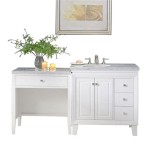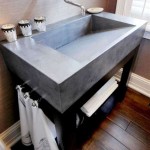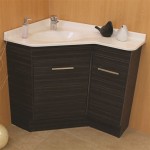Is Cultured Marble Good For Bathroom Countertops?
Cultured marble has been a popular choice for bathroom countertops for several decades, offering a blend of aesthetics and practicality that appeals to many homeowners. Its manufactured nature allows for a wide range of colors, patterns, and integrated features. Determining whether cultured marble is a "good" choice for a bathroom countertop depends on understanding its composition, characteristics, advantages, and disadvantages compared to other countertop materials.
Cultured marble is a composite material made from crushed natural marble stone that is mixed with polyester resins and pigments. This mixture is then cast in molds to create the desired countertop shape, including integrated sinks and backsplashes. A gel coat is typically applied to the surface to provide a glossy, protective finish. The manufacturing process allows for consistent quality and enables the creation of intricate designs that would be difficult or impossible to achieve with natural stone.
Durability and Maintenance
Cultured marble offers reasonable durability for bathroom countertops, but it is essential to understand its limitations. The gel coat provides a degree of protection against stains and water damage, which are common concerns in bathroom environments. However, this coating is susceptible to scratches and chips, especially from abrasive cleaners or dropped objects. Once the gel coat is damaged, the underlying material becomes more vulnerable to staining and water absorption.
Regular cleaning with mild soap and water is the best way to maintain cultured marble countertops. Avoid using harsh chemicals, abrasive cleaners, or scouring pads, as these can scratch or dull the surface. Spills should be wiped up promptly to prevent staining, particularly from hair dye, cosmetics, or acidic substances. While cultured marble is generally resistant to mold and mildew, it is still important to keep the countertop clean and dry to prevent their growth in grout lines or around the sink.
Repairing minor scratches or chips in the gel coat of a cultured marble countertop can be done with a repair kit specifically designed for this purpose. These kits typically contain a color-matched resin that can be applied to the damaged area, sanded smooth, and polished to restore the original finish. However, more extensive damage may require professional repair or even countertop replacement.
Compared to other popular countertop materials, cultured marble is less durable than granite, quartz, or solid surface materials. Granite and quartz are naturally highly resistant to scratches, stains, and heat. Solid surface materials, like Corian, are also more resistant to damage and can often be repaired seamlessly. However, cultured marble is generally more durable than laminate countertops, which are susceptible to water damage and peeling.
Aesthetics and Design Options
One of the main advantages of cultured marble is the wide range of aesthetic options it offers. The manufacturing process allows for virtually unlimited colors and patterns, including veining that mimics natural marble or granite. Integrated sinks are another common feature, creating a seamless and hygienic surface that is easy to clean. Cultured marble can also be molded into various shapes and sizes, allowing for custom designs that fit specific bathroom layouts.
The glossy finish of cultured marble can create a bright and clean look in a bathroom. While the high-gloss finish is traditional, matte finishes are also available, offering a more contemporary aesthetic. The ability to incorporate different edge profiles, such as bullnose or ogee, further enhances the design possibilities.
However, some people find that cultured marble lacks the natural beauty and depth of natural stone. While cultured marble can mimic the appearance of natural stone, it often lacks the subtle variations and unique characteristics that make each slab of granite or marble truly one-of-a-kind. The manufactured nature of cultured marble can sometimes result in a more uniform and less organic look.
The color and pattern options for cultured marble can be overwhelming, and it is important to choose a design that complements the overall style of the bathroom. Neutral colors and classic patterns are generally a safe choice, while bolder colors and patterns can create a more dramatic effect. It is advisable to consider the long-term appeal of the chosen design, as replacing a countertop can be a significant expense.
Cost Considerations
Cultured marble is generally a more affordable option than natural stone countertops such as granite or marble. It is also often less expensive than quartz countertops and some solid surface materials. The cost of a cultured marble countertop will depend on factors such as the size, shape, color, pattern, and any integrated features like sinks and backsplashes. Installation costs can also vary depending on the complexity of the project.
When comparing the cost of cultured marble to other countertop materials, it is important to consider the long-term value. While cultured marble may have a lower initial cost, its lower durability compared to granite or quartz could result in higher repair or replacement costs over time. Solid surface materials offer a balance of durability and affordability, while laminate countertops are the least expensive option but also the least durable.
It is advisable to obtain quotes from multiple countertop suppliers and installers to compare prices and ensure that you are getting the best value for your money. Be sure to ask about warranties and guarantees, as well as the cost of any necessary plumbing or electrical work.
The cost of cultured marble can also be influenced by regional variations and the availability of different colors and patterns. In some areas, cultured marble may be more readily available and therefore more affordable than in others. It is also worth considering whether to purchase a pre-fabricated cultured marble countertop or have one custom-made. Pre-fabricated countertops are generally less expensive but offer fewer design options.
Environmental Impact
The environmental impact of cultured marble is a factor to consider when making a countertop selection. Cultured marble is made from a combination of natural marble dust and synthetic resins. The extraction of marble dust can have environmental consequences, such as habitat disruption and water pollution. The production of polyester resins also involves the use of fossil fuels and can release harmful emissions into the atmosphere.
However, cultured marble can also be considered a more sustainable option than some other countertop materials. It utilizes marble dust, which is a byproduct of marble quarrying and processing, reducing waste. The manufacturing process of cultured marble typically generates less waste than the fabrication of natural stone countertops.
Compared to natural stone countertops that are quarried and transported from distant locations, cultured marble can often be manufactured locally, reducing transportation costs and emissions. Some manufacturers are also using recycled materials in their cultured marble formulations, further reducing their environmental impact.
Consumers can reduce the environmental impact of their countertop selection by choosing cultured marble products that are made from recycled materials or that are certified by environmental organizations. Proper maintenance and care of cultured marble countertops can also extend their lifespan, reducing the need for replacement and minimizing waste.
Integrated Sinks and Backsplashes
A significant advantage of cultured marble is its ability to incorporate sinks and backsplashes seamlessly into the countertop. This integrated design eliminates seams and grout lines, which can be difficult to clean and prone to mold and mildew growth. Integrated sinks and backsplashes create a clean and hygienic surface that is easy to maintain.
The integrated sink can be molded in a variety of shapes and sizes to suit different bathroom styles and needs. Common options include oval, rectangular, and square sinks. The depth of the sink can also be customized to accommodate different plumbing fixtures and user preferences.
The integrated backsplash can be designed to extend up the wall to any desired height, providing protection against water splashes and creating a visually appealing backdrop for the countertop. The backsplash can also incorporate decorative elements, such as grooves, patterns, or contrasting colors.
While integrated sinks and backsplashes offer many advantages, they also have some potential drawbacks. If the sink or backsplash is damaged, it may be necessary to replace the entire countertop. It is also important to choose a design that is compatible with the bathroom's plumbing and electrical systems.
The seamless integration of sinks and backsplashes in cultured marble countertops is a unique feature that sets it apart from many other countertop materials. This feature can significantly enhance the aesthetics and functionality of a bathroom.
Ultimately, determining whether cultured marble is a "good" choice for bathroom countertops requires weighing the factors of durability, aesthetics, cost, environmental impact, and integrated features against the specific needs and preferences of the homeowner. Each material possesses a unique set of characteristics that may align better with some projects than others.

Cultured Marble Vs Granite Choosing The Best Material In 2024 Com

Cultured Marble Countertops An Overview R D Conroe Tx

Difference Between Real And Cultured Marble Chome

Cultured Marble Kitchen Bath Center

What You Need To Know About Cultured Marble Vanity Tops Granite Countertops In Maryland

Easy Budget Sink Update Momhomeguide Com

Cultured Marble Vanity Tops Wolf Home S

Marble Complete Home Concepts

Marlin Marble Cultured

Cultured Marble Vanity Tops Wolf Home S







